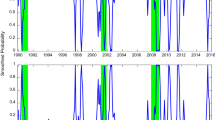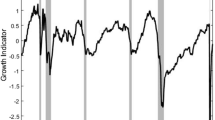Abstract
This article proposes a straightforward Markov-switching asset allocation model, which reduces the market exposure to periods of high volatility. The main purpose of the study is to examine the performance of a regime-based asset allocation strategy under realistic assumptions, compared to a buy-and-hold strategy. An empirical study, utilizing daily return series of major equity indices in the United States, Japan and Germany over the past 40 years, investigates the performance of the model. In an out-of-sample context, the strategy proves profitable after taking transaction costs into account. For the regional markets under consideration, the volatility reduces on average by 41 per cent. In addition, annualized excess returns attain 18.5 to 201.6 basis points.


Similar content being viewed by others
References
Ammann, M. and Verhofen, M. (2006) The effect of market regimes on style allocation. Financial Markets and Portfolio Management 20 (3): 309–337.
Ang, A. and Bekaert, G. (2002) International asset allocation with regime shifts. The Review of Financial Studies 15 (4): 1137–1187.
Ang, A. and Bekaert, G. (2004) Timing and diversification: A state-dependent asset allocation approach. Financial Analysts Journal 60 (2): 86–99.
Bauer, R., Haerden, R. and Molenaar, R. (2004) Timing and diversification: A state-dependent asset allocation approach. Journal of Investing 13 (3): 72–80.
Baum, L.E. and Petrie, T. (1966) Statistical inference for probabilistic functions of finite state Markov chains. Annals of Mathematical Statistics 37: 1554–1563.
Baum, L.E., Petrie, T., Soules, G. and Weiss, N. (1970) A maximization technique occurring in the statistical analysis of probabilistic functions of Markov chains. Annals of Mathematical Statistics. 41: 164–171.
Bialkowski, J. (2003) Modelling returns on stock indices for western and central European stock exchanges – Markov switching approach. South Eastern Europe Journal of Economics 2 (2): 81–100.
Brinson, G., Singer, B.D. and Beebower, G.L. (1991) Determinants of portfolio performance II: An update. Financial Analysts Journal 47 (3): 40–48.
Bulla, J. (2010) Hidden Markov Models with t components. Increased persistence and other aspects. Quantitative Finance, DOI: 10.1080/14697681003685563 (http://www.informaworld.com/smpp/content~db=all~content=a923661307~frm=titlelink).
Bulla, J. and Berzel, A. (2008) Computational issues in parameter estimation for stationary hidden Markov models. Computational Statistics 23 (1): 1–18.
Bulla, J. and Bulla, I. (2006) Stylized facts of financial time series and hidden semi-Markov models. Computational Statistics & Data Analysis 51 (4): 2192–2209.
Cappé, O., Moulines, E. and Rydén, T. (2007) Inference in Hidden Markov Models. Heidelberg, Berlin, NY: Springer-Verlag.
Carhart, M.M. (1997) On persistence in mutual fund performance. Journal of Finance 52 (1): 57–82.
Dacco, R. and Satchell, S. (1999) Why do regime-switching models forecast so badly? Journal of Forecasting 18 (1): 1–16.
Dempster, A.P., Laird, N.M. and Rubin, D.B. (1977) Maximum likelihood from incomplete data via the EM algorithm. Journal of the Royal Statistical Society. Series B 39 (1): 1–38.
Goldfeld, S.M. and Quandt, R.E. (1973) A Markov model for switching regressions. Journal of Econometrics 1 (1): 3–16.
Graflund, A. and Nilsson, B. (2003) Dynamic portfolio selection: The relevance of switching regimes and investment horizon. European Financial Management 9 (2): 179–200.
Guidolin, M. and Timmermann, A. (2005) Economic implications of bull and bear regimes in UK stock and bond returns. Economic Journal 115 (500): 111–143.
Hamilton, J.D. (1989) A new approach to the economic analysis of nonstationary time series and the business cycle. Econometrica 57 (2): 357–384.
Hess, M.K. (2006) Timing and diversification: A state-dependent asset allocation approach. The European Journal of Finance 12 (3): 189–204.
Linne, T. (2002) A Markov switching model of stock returns: An application to the emerging markets in Central and Eastern Europe. In: Charemza, W. and Strzała, K. (eds.) East European Transition and EU Enlargement. Heidelberg, Germany: Physica-Verlag, pp. 371–384.
MacDonald, I.L. and Zucchini, W. (2009) Hidden Markov for Time Series: An Introduction Using R. London: Chapman & Hall.
Maruotti, A. and Rydén, T. (2009) A semiparametric approach to hidden Markov models under logitudinal observations. Statistics and Computing 19 (4): 381–393.
Michaud, R.O. (1989) The Markowitz optimization enigma: Is ‘optimized’ optimal? Financial Analysts Journal 45 (1): 31–42.
Quandt, R.E. (1958) The estimation of the parameters of a linear regression system obeying two separate regimes. Journal of the American Statistical Association 53 (284): 873–880.
Quandt, R.E. (1972) A new approach to estimating switching regressions. Journal of the American Statistical Association 67 (338): 306–310.
Rabiner, L.R. (1989) A tutorial on hidden Markov models and selected applications in speech recognition. IEEE Transactions on Information Theory 77 (2): 257–284.
Rydén, T., Terasvirta, T. and Asbrink, S. (1998) Stylized facts of daily return series and the hidden Markov model. Journal of Applied Economics 13 (3): 217–244.
Schwert, G.W. (1989) Why does stock market volatility change over time. Journal of Finance 44 (5): 1115–1153.
Turner, C.M., Startz, R. and Nelson, C.R. (1989) A Markov model of heteroskedasticity, risk, and learning in the stock market. Journal of Financial Economics 25 (1): 3–22.
Viterbi, A.J. (1967) Error bounds for convolutional codes and an asymptotically optimum decoding algorithm. IEEE Transactions on Information Theory 13 (2): 260–269.
Acknowledgements
We sincerely thank P. Thomson and W. Zucchini for their inspiring comments and support. We also render thanks to the participants of the Cherry Bud Workshop 2007 and the 17th NZESG for helpful feedback. Not to forget, we thank G. Allardice for editorial assistance, as well as W. Allardice and Prof. D. Vere-Jones for the great working environment. Jan Bulla was supported by a fellowship within the Postdoc-Program of the German Research Foundation (DFG).
Author information
Authors and Affiliations
Corresponding author
Additional information
4holds a PhD in mathematics, his main research interests lie in statistics and probability theory. He teaches classes in statistics, probability theory and computer science up to graduate level at the mathematics department of Caen University. Moreover, he is involved in a research program with the department of biology and has published in the field of algebra.
5received the PhD degree in Statistics in 2006 from the University of Pierre et Marie Curie, Paris 6, France. Currently he is an associate professor in the Department of Mathematical Sciences of Caen University. His current research deals with non-parametric statistics, wavelets, Markov processes, econometrics and finance. His teaching experience includes a number of undergraduate level modules in the area of probability and econometrics.
Rights and permissions
About this article
Cite this article
Bulla, J., Mergner, S., Bulla, I. et al. Markov-switching asset allocation: Do profitable strategies exist?. J Asset Manag 12, 310–321 (2011). https://doi.org/10.1057/jam.2010.27
Received:
Revised:
Published:
Issue Date:
DOI: https://doi.org/10.1057/jam.2010.27




